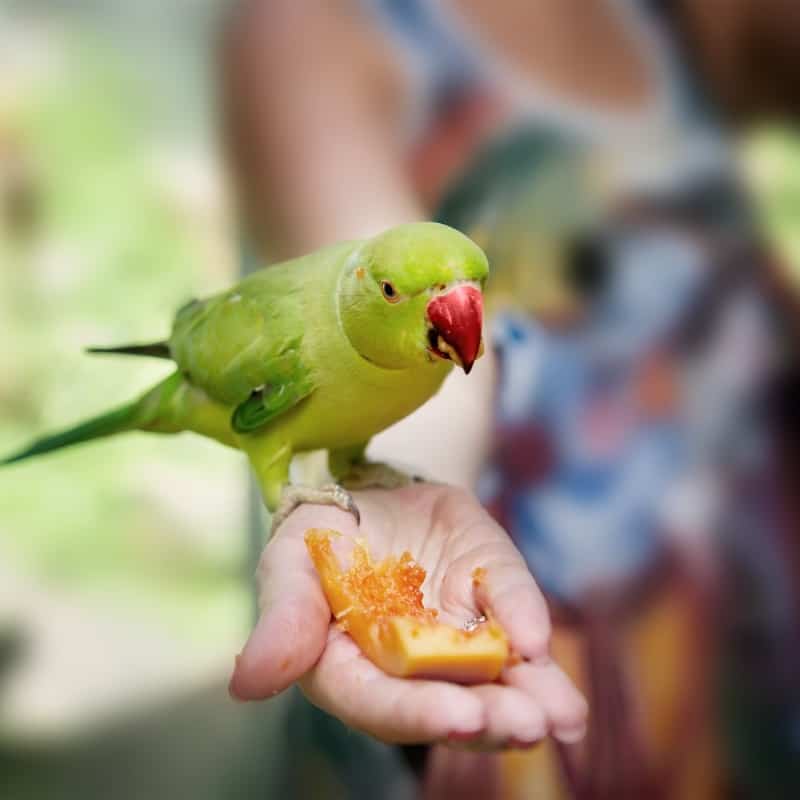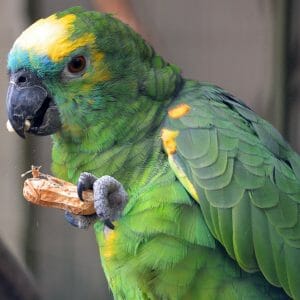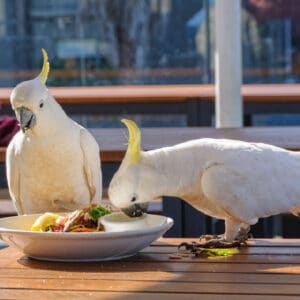
Essential Tips for Feeding Pet Birds Safely
Last Updated on by Catherine Tobsing
Nourishing your feathered companions involves much more than just providing them with a daily scoop of pet bird food.
Adequate feeding of pet birds is an intricate part of avian health, demanding a balanced diet rich in nutrients essential for their vitality.
Bird nutrition is not a mere sidebar in pet care; it’s the headline act for preventing a range of diseases.
Diet mishaps account for an alarming 80-90% of health troubles in pet birds.
Discovering the right blend of foods, which avoids the pitfalls of a seed-only regimen, constitutes the cornerstone for a life of feathered flourish.
Key Takeaways
- A scrupulous blend of pelleted pet bird diet and fresh foods marks the zenith of bird nutrition.
- Supplementation with vitamins and minerals should be judicial, preventing the hazard of overdose.
- Choosing esteemed brands such as Higgins and Lafebers can quintessentially shape your bird’s health landscape.
- Mindful introduction of new food must be gradual, ensuring an adjusted and accepting bird palate.
- Stay vigilant of spoiling fresh foods and preemptively replace them to uphold food safety.
- Familiarizing oneself with the satiating and healthful merits of varied fruits, vegetables, and treats bestows upon your pet bird a dietary renaissance.
Understanding Your Pet Bird’s Nutritional Needs
As a dedicated pet bird owner, it’s vital to recognize the significance of a balanced avian diet for the wellness of your feathered companions.
The diet of pet birds should comprehensively reflect the rich variety of nutrients and foods available in their natural environment, where a blend of seeds, nuts, fruits, insects, and other plant materials contribute to their optimal health.
Importance of a Balanced Diet for Pet Birds
Leading brands like Higgins, Hagen HARI, Goldenfeast, and TOPS have taken significant strides in tailoring their bird food offerings to meet these nutritional benchmarks.
Their formulas ensure that the essential nutrients required for avian vitality are present, helping pet birds thrive in their domestic environments.
A diet that lacks variability and healthy choices may deprive your bird of the full spectrum of vitamins, proteins, and minerals that can prevent common health issues and foster longevity.
Identifying Quality Pet Bird Food Brands
It is paramount for bird owners to seek out and choose high-quality bird food brands.
By choosing their products, owners can take comfort in knowing they are providing meals that will not only satisfy their pet’s palate but also contribute to a heartier, happier bird.
In taking this holistic approach to your bird’s feeding routine, remember to consider the benefits of a variety of food sources.
Ensure that seeds are not the solitary feature on the menu, but rather one of many nutritious options shaping your bird’s daily intake.
The Role of Pellets in Feeding Pet Birds
Integrating pelleted pet bird diets into your pet bird’s meal plan is a strategic choice that can profoundly impact their overall nutrition and well-being.
Unlike traditional seed-based feeds, bird pellets are formulated to deliver a harmonious blend of essential vitamins, minerals, and protein necessary for a flourishing life.
Top-tier brands like Hagen, Tops, and Harrison’s are at the forefront, advocating for the transition to these nutrient-dense options.
It’s understood that switching your feathered friend to a pellet-centered diet might be met with some resistance, but the benefits are well worth the effort.
Indeed, the uniformity of pellets ensures that each bite your bird takes is packed with balanced nutrition, a feature seeds alone fail to provide.
One effective method to encourage acceptance of pellets is presenting them early in the day when hunger levels peak.
Implementing this change gradually often results in improved health, a more vibrant plumage, and enhanced vitality, indicating the life-giving power of a carefully curated diet. Patience and consistency are key as you transform your pet’s eating habits for a longer and healthier companionship.
Incorporating Fresh Foods into Your Bird’s Diet
Introducing *fresh fruits and vegetables* to your bird’s feeding regimen brings a cornucopia of vitamins and hydration into their diet, starkly contrasting the dryness of solely seed-based meals. In achieving *dietary diversity*, you not only cater to your bird’s nutritional needs but also enrich their daily life, replicating *bird feeding habits* found in the wild. Nourishing your feathered friends with a multitude of fresh produce is essential for both physical and mental well-being.
Essential Fruits and Vegetables for Avian Health
Bright orange carrots, vitamin-rich kale, and fibrous broccoli make up a powerhouse of essential vegetables for your avian’s health. Your pet can enjoy the sweet crunch of an apple or the juiciness of a pear, provided you’ve meticulously removed any potentially harmful seeds.
It’s wise to steer clear of canned options that often contain unhealthy levels of sugars and salts, which can be detrimental to your bird’s health.
How to Safely Introduce New Foods to Your Bird
To smoothly integrate new flavors and textures, start by offering small portions of new foods alongside familiar favorites.
This gradual approach helps avoid the shock of abrupt change, while also ensuring they are not left hungry. Observe your bird’s reaction to the new foods and fecal consistency, as changes might occur with the introduction of wetter foods.
A little patience goes a long way, as does vigilance for signs of distress, which could indicate an aversion or sensitivity to new food items.
“The secret to a healthy bird lies in the delightful variety of its diet. Embrace the colors and shapes of nature’s bounty, for they bring vigor and vitality to your avian companion.”
Feeding Pet Birds: Dietary Diversity and Treats
Ensuring dietary diversity in your pet bird’s routine is not just about health—it’s about happiness, too. Just as we enjoy a variety of foods to eat, so do our feathered friends. Appropriate bird treats can supplement their diet with beneficial nutrients, offer a delightful change of pace, and play an integral role in their daily enrichment.
Healthy Treat Options for Your Feathered Friend
Lafeber’s Nutriberries are a perfect example of a treat that is both tasty and nutritious. Unlike conventional seed mixes, Nutriberries are formulated to deliver a more balanced nutrition profile, making them an excellent choice for a supplemental snack.
Other healthy snacks include small pieces of fruits or veggies, and the occasional nibble of whole grain bread or unsweetened cereal, ensuring you keep your bird’s wellbeing at the forefront.
How to Use Treats to Encourage Foraging Behaviors
Foraging is an instinct for birds, and you can encourage this behavior by incorporating treats into their activities. Hiding treats inside foraging toys not only satiates their need to search for food but also provides much-needed mental stimulation.
It’s a delightful way to integrate healthy snacks into their routine while simultaneously creating an interactive experience akin to their natural habitat.
Conclusion
Achieving optimal avian health requires more than just a passing thought about what goes into your pet bird’s feeder. As we’ve delved into throughout this article, feeding pet birds is an intricate balancing act that demands attention to a variety of nutritional components.
By leaning towards a balanced bird diet that emphasizes an array of high-quality pellets, augmented by the freshness and vitality of fruits and vegetables, pet owners can sidestep the common pitfalls associated with heavy seed diets.
Moreover, bird nutrition isn’t just about what’s in the bowl – it’s about engagement and variety. The thoughtful introduction of dietary diversity stimulates not just physical health, but mental acuity as well.
Using treats sensibly, whether as rewards or as part of enriching activities, must be done with an eye on moderation and nutritional value. Properly assessing and patiently facilitating dietary reforms are pivotal aspects of caring for these intelligent creatures.
Ultimately, the well-being of our feathered friends hinges upon our willingness and ability to understand and cater to their specific dietary needs. Observant pet caregivers who nurture this balance can look forward to a vibrant life shared with their birds, full of song and vigor. It’s a rewarding journey that underscores the profound connection between conscientious care and the thriving nature of our avian companions.
FAQ
What constitutes a balanced diet for a pet bird?
A balanced diet for a pet bird includes a combination of high-quality pellets, fresh fruits and vegetables, and a limited amount of seeds and treats. Pellets should make up the majority of the diet, while fresh produce provides essential nutrients and hydration. Seeds and treats can be offered in moderation to encourage foraging behaviors.
Why is an all-seed diet harmful to pet birds?
An all-seed diet is often high in fat and lacks many essential nutrients that birds require for optimal health, such as calcium, iodine, amino acids, and vitamins A and B. A diet excessive in seeds can lead to obesity, heart disease, and liver problems in birds. Introducing pellets and diverse foods helps prevent these issues.
How do I identify high-quality pet bird food brands?
High-quality pet bird food brands, such as Higgins, Hagen HARI, Goldenfeast, and Tops, are known for their nutritional formulations that include a variety of seeds, nuts, fruits, vegetables, and added vitamins and minerals. Look for brands that offer organic, preservative-free options and cater to the specific needs of your bird’s species.
What role do pellets play in a bird’s nutrition?
Pellets are designed to provide complete and balanced nutrition with each bite, making them an essential part of a bird’s diet. They help ensure birds get all the necessary nutrients for their health, which might be missing in an all-seed diet. Brands like Higgins, Hagen Hari, and Harrison’s produce pelleted diets suitable for different avian species.
Which fruits and vegetables are essential for avian health?
Essential fruits and vegetables for avian health include carrots, kale, broccoli, apples, and pears. These fresh foods provide a wide range of vitamins, minerals, and antioxidants that are crucial for maintaining good health in birds. It’s important to feed appropriate portions and to avoid any potentially toxic parts, such as certain seeds or pits.
How should I introduce new foods to my bird’s diet?
Introduce new foods gradually to your bird’s diet. Offer them in small amounts alongside familiar foods. It’s best to introduce new items during the morning when birds are hungriest. Monitor your bird’s reaction to new foods and remove any uneaten fresh food to prevent spoilage. Patience is key as some birds may take a while to accept new flavors and textures.
How can I use treats to encourage natural foraging behaviors in my bird?
Treats can be used to encourage foraging behaviors by hiding them inside foraging toys that require the bird to work to obtain them. This not only provides mental stimulation but also simulates natural feeding behaviors seen in the wild. Scatter treats in the bird’s environment or use puzzle toys to keep them engaged and active.
Written and Approved by Mitch Rezman, Catherine Tobsing, and the Windy City Parrot Content Team.
Your Zygodactyl Footnote
Author Profile
Latest entries
 The Traveling BirdJune 26, 2025Can You Name 5 Parrot Species That Are Living Wild in the USA?
The Traveling BirdJune 26, 2025Can You Name 5 Parrot Species That Are Living Wild in the USA? Bird BehaviorJune 26, 2025How is it Parrots Are Problem Solvers Social Animals and Even Use Tools?
Bird BehaviorJune 26, 2025How is it Parrots Are Problem Solvers Social Animals and Even Use Tools? Bird & Parrot AnatomyJune 25, 2025How a Tiny Chemical Modification Makes Parrots Nature’s Living Paintings
Bird & Parrot AnatomyJune 25, 2025How a Tiny Chemical Modification Makes Parrots Nature’s Living Paintings PigeonsJune 20, 2025How Do Parrots Thrive in Cities Outside Their Native Habitats?
PigeonsJune 20, 2025How Do Parrots Thrive in Cities Outside Their Native Habitats?


